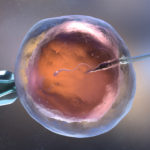In Vitro Fertilization (IVF)
IUI vs. IVF: Success Rates and Determining the Right Treatment for You

When a couple is having difficulty conceiving, there is a spectrum of treatment options ranging from “low tech” treatment (like oral agents with timed intercourse or intrauterine insemination (IUI)) all the way to more “high tech” treatment, such as in vitro fertilization (IVF). Often, patients ask, “Is IUI a waste of time and money?”
There are many factors to take into account when determining which treatment path is best. These include:
- Cause of the Infertility
- Age
- Cost
- Success Rates
- Invasiveness of the Treatment
The less aggressive treatment options are easier and less expensive, but also much less effective. The most aggressive treatment option is in vitro fertilization (IVF). It is less convenient but dramatically more effective.

Infertility Treatment Success Rates
To put things in perspective, it is important to understand the expected success rates per cycle for each treatment option. Once a couple with unexplained infertility has been trying to conceive for a year without success, there is a 1-4% chance that they will conceive on their own each subsequent month without any treatment (compared to a fertile couple who has a ~20-25% chance of conceiving on their own each month). If a couple pursues an oral agent (such as Clomid or Letrozole) and timed intercourse, the chance of conceiving a successful pregnancy is ~5-6% each cycle.
Trying IUI without any medications offers a ~4% pregnancy rate. Clomid or letrozole plus IUI offers an ~8% pregnancy rate per cycle. Oral agents are fairly well-tolerated, inexpensive, and have a relatively low rate of multiple pregnancies (<10%). The only downside is that they are not particularly effective (with or without IUI) in women who are already ovulating each month.
IVF Success Rates
IVF is a safe, very effective treatment option for couples with infertility. IVF involves injectable hormones to help the ovaries mature a number of eggs all at the same time. Once the eggs are deemed “ready” they will be harvested through a simple 5-10 minute outpatient procedure under anesthesia. The eggs are then introduced to sperm in the IVF laboratory. The eggs that successfully fertilize are called embryos. The embryos are observed for 2-5 days in the laboratory, and then usually, one or two of the strongest-appearing embryos will be transferred back to the uterus.
Many patients will have extra embryos left over that can be frozen for future use. Pregnancy rates are dictated by age and other prognostic indicators. Good prognosis patients will have a 50-55% chance (or greater) of a successful pregnancy with each IVF cycle. For all couples, IVF offers the fastest path to pregnancy.
How to Know Which Infertility Treatment is Best For You
It is important that each couple proceeds at the pace that is right for them. While fertility treatment often feels like a marathon, the majority of couples will ultimately be successful. We are very proud of our program at Fertility Centers of New England. Our pregnancy rates remain outstanding, and we offer one of the most cost-competitive programs available. When you begin treatment with us, our experienced staff will review all of your financial options for fertility treatment, from insurance to financing. Our special pricing programs are designed to meet the individual needs of patients and can help you choose the path that is right for you.
View Our Special Pricing Programs
Contact Us
Your Fertility Centers of New England fertility doctor will work to determine what treatment is best for you. If you have questions such as “Is IUI a waste of time and money?” or other concerns about your fertility, please contact us for an initial consultation. We are here to help.


